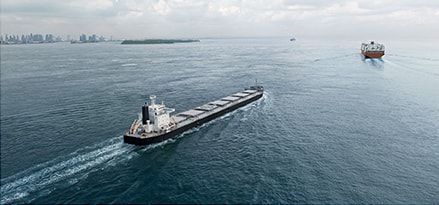Introduction
We are providing this information because the importance of a suitably drawn and witnessed representative sample cannot be over-emphasized. The commercial sample forms the basis of all product quality dispute resolutions between a supplier and customer, and the MARPOL sample provides product quality evidence to Port State Control Authorities, if required.
ExxonMobil maintains a Sampling Policy based on sound bunkering principles, MARPOL Annex VI resolution MEPC.182(59) as well as Industry Standards (ISO 13739). It covers the method of taking the sample, location and witnessing.
Continuous sampling methods
Continuous sampling throughout the bunkering operation is the preferred method to ensure accurate sample composition. MARPOL guidelines state that the sampling location should be at the receiving vessel’s inlet bunker manifold; however, ISO 13739 and ExxonMobil recommend that the sampling location may be at either end of the bunkering hose. Locating the sampler at the barge end of the delivery hose offers several advantages, such as: safe access by barge personnel and independent surveyors; it is in clear view of all interested parties; it is permanently fitted, thereby reducing connection time; and the risk of damage is reduced.
Special care must be taken to ensure that new, unused containers are used for sampling. Prior to the commencement of bunkering, the sampling device must be cleaned or flushed to ensure no sample contamination can occur from previous products. Personnel must ensure that no rain or debris is allowed to contaminate the samples. Each sample must be sealed with the seal identification number listed on the product delivery Bunker Delivery Note (BDN).
Each sample should be of sufficient quantity to perform the tests required and are normally 500-750 mL in size. The MARPOL sample must not be less than 400 mL.
Sample requirements
The following information is required to be on all sample labels to comply with MARPOL 182(59) Regulation 8:
- Location at which, and the method by which, the sample was drawn
- Date of commencement of delivery
- Name of bunker tanker/bunker installation
- Name and IMO number of the receiving ship
- Signatures and printed names of the supplier’s representative and the ship’s representative
- Details of seal identification
- Bunker grade
Post-sampling process
Commercial samples should be retained for evidentiary purposes for a period of no less than 90 days from the date of delivery. MARPOL samples must be retained on board until the fuel is substantially consumed; but in any case, for a period of no less than 12 months from the time of delivery. The MARPOL sample can only be released by the Port State Control Authorities or Flag State administration authorities, and it shall be analysed in accordance with the verification procedure set forth in Appendix VI of the Revised MARPOL Annex VI.
Please note that this method is different than ISO 8217 and ISO 4259 testing methods for Sulphur verification.
Summary
- A representative sample, properly obtained, is fundamental for all later testing of the product.
- Continuous drip manual sampler, of an approved design, is a proven method for effective sampling.
- The sample must be witnessed by both the Supplier’s (ExxonMobil) Representative and the Customer’s Representative.
- All samples should be handled and stored carefully.
- Disposal of samples, sample containers and cubitainers should be done so in compliance with local environmental regulations.


